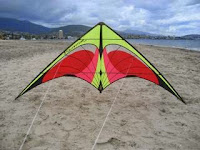Years ago, as a child, I too, had experienced the running and failure to launch, only to try and try again. Sometimes the attempts paid off and the kite would soar, but not often enough to call kite flying fun.
I realized that my friend didn't know about the high tech kites of today. I told her of my surprise and delight when my daughter introduced me to kite flying. I had not known about high tech kites either. Whenever I visit my daughter and her husband, they often plan suggested activities and outings for the days of my visit. During a visit several years ago, my daughter asked if I'd like to go kite flying.
 |
| Stunt Kite |
Selections from Wikipedia on Kites
Kites were invented in China in 5th century BC. Using bamboo and silk for the sail and line, they were decorated with mythological motifs and often had whistles attached.
They were also used for measuring distance, lifting men, and signaling. Introduced into Cambodia, India, Japan and Korea, they were unknown in Europe. The Romans used only windsocks and banners. Marco Polo and sailors from Japan and Malaysia brought them to Europe as curiosities.
Scientific research started in the 18th and 19th centuries. Ben Franklin published a proposal for an experiment to prove lightening was caused by electricity, but it is not known if Franklin ever performed it. The Wright brothers used kite research when they built the 1st airplane in the 1800s.
The kites of today are single line, multiline, stunt, quad, power and ultra light; all are designed to be maneuverable in the sky by fliers. Quad kites can hover, rotate in place, and stop and teams lying quads in formation perform spectacular displays.

No comments:
Post a Comment